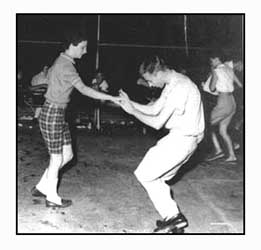If you are from the South, and you do swing dance, you do the Carolina Shag. It is THE swing dance of the south. Moreover, Shag is imbibed with a certain mystique. As one old-timer describes it, "Shag is a warm night with a cold beer and a hot date." Even without the beer, Shag carries with it the nostalgia of cool wind and ocean waves on a warm summer's night, hand in hand with someone you like a lot.
Originating in the late '30s on the shores of Myrtle Beach, Shag has gained such a following that it is now the Official State Dance of South Carolina. Over 15,000 Shaggers attend the Myrtle Beach "Spring Safari" in March, with an almost equal number showing up to dance at the September "Fall Migration". There are more Shag Clubs in 4 states in the South than there are any other one type of swing dance club in the world.
The roots of shag can be found in the cross-pollination of black music and club dancers in Myrtle Beach with the natural openness of a fun-loving and carefree group of '40s white teenagers. The racially myopic mainstream radio stations of the '40s South did not play black music. The kids had flock to the beaches to hear it on jukeboxes.
Certain individuals, such as Billy Jeffers (photo) and "Chicken" Hicks are credited with developing the early aspects of the dance. These teens attended black night clubs and were allowed to watch from the balcony. In an era of segragation, this was called "jumping the Jim Crow rope." They adapted what they saw and liked. They are also credited with initiating the "Beach Music" phenomenon, by convincing jukebox owners to put R&B into the playlist. In the '90s, numerous radio stations have Beach Music-only formats.
Lindy Hoppers are familiar with the "Big Apple" dance and perhaps with its derivative partner-ish dance the "Little Apple". Both of these were born at Fat Sam's Big Apple Club in Columbia, South Carolina. It then drifted up north to the Savoy Ballroom where it inspired the famous choreographer and performance dancer Frank Manning. Jazz affected the Southern style directly, although its Savoy transmutations also returned home to the South. Early Shaggers called themselves "Jitterbugs". The music was fast, and it was big band swing. The term "Shag" came about over a decade later. By the early '50s, Shag had slowed way down and adopted the tempo and feel of Rhythm and Blues as its own.
In the post-WWII era, with the close of the Savoy Ballroom and demise of the big bands, the Lindy Hop lost most of its USA popularity (resurfacing in the '90s). However, Carolina Shag in the South grew and grew...
|
"Spider" Kirkman and ???, Myrtle Beach SC, early 1950s
|

|
The 'Shag' Described...
The shag 'basic' is one of the most comfortable partnering basic steps in swing dance. The connection is relaxed, but steady: no subtle leverage and compression as in West Coast Swing. Compared to the East Coast Swing basic, it doesn't bounce: it glides. A lot of repetition doesn't tire out the beginner, as it does for those who regard the "Swing-Out" as Lindy Hop's basic. The shag basic is smooth, and really feels great with the right music. (No judgements here, just trying to describe... we do 'em all, we love 'em all.)
The dance has a variety of styles, depending on who is dancing, or on who describes it to you! For some, the dance is playful, with a lot of partner interaction, and both partners taking opportunities to "shine". For others, it is "mirror moves" galore. For yet others, the leader "peacocks" a variety of complex improvisations, while the follower performs subtle (or no) footwork variations. It depends on the skill level and mentality of each partner, as well as on regionality and decade. At the forefront of mutual partnering in shag are national shag champions many times over, Jackie McGee and Charlie Womble.
Mirror Moves: Often mentioned when attempting to describe Shag, complex moves involving both partners doing the same thing as if in a mirror are definitely an aspect of the dance. Advanced couples often develop their own personal repertoire of mirrored sequences using crosses, hooks, kicks, brushes, turns, spins, etc. These sequences are essentially unleadable, except by verbal call. It is fun to make these up and execute them. They are personal moments of a private language to rejoice in. However, there are also plenty of lead-follow moves. The shag basic itself seems to invite the creation of mirror moves, since it is itself a mirror step.
On Myrtle Beach, the Shag Contest phenomenon may be partially responsible for the high degree of development of complex couples' moves. But, there is also a large percentage of shaggers who are totally uninterested in competition!
Most shaggers today keep the action strictly in the footwork.... The footwork stays close to the ground. No high kicks. Also, no aerials or lifts. The partnering is warm, playful and affectionate, but not pseudo-seductive viz-a-viz a trend in '90s West Coast Swing. (Paradoxically, the Shag "Belly Roll" is the one really hot (as in "sex") move that '90s West Coast Swingers might seem to want to do, but don't!)
Will Carolina Shag ever become popular up north? It is my observation that the dance is heavily tied into Southern identity, Southern sociability, and Myrtle Beach mystique. The attempt to regard Carolina Shag as just another cool swing dance is to miss this essential context.